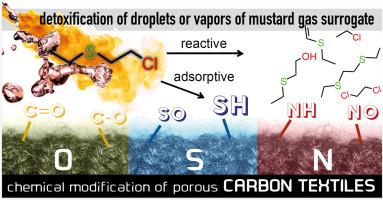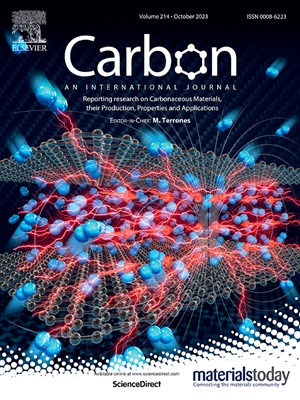碳织物表面功能性在反应吸附蒸汽和液体 2-氯乙基硫醚中的作用:评估界面上的相互作用
IF 10.5
2区 材料科学
Q1 CHEMISTRY, PHYSICAL
引用次数: 0
摘要
对一种碳织物(CT)进行了化学改性,以提高其表面活性,促进芥子气的代用品--2-氯乙基硫醚(CEES)的吸附和降解。首先对 CT 进行氧化(CTO),然后在氨气(CTON)或硫化氢(CTOS)气氛下加热,分别加入氮或硫的官能团。解毒实验在封闭的小瓶中进行,使用的是蒸汽或液体形式的 CEES。CT、CTO、CTOS 和 CTON 的最大蒸气重量吸收率分别为 399、372、434 和 489 mg/g。所有纺织品都能阻止 CEES 液滴的汽化。虽然在气态和液态系统中都检测到了类似的反应产物,但纺织品表面 CEES 化学转化程度的明显差异表明,受表面化学影响的解毒途径各不相同。尽管 CTO 的异质表面富含氧表面基团,促进了各种反应,但水解是最主要的途径。无论在何种气氛下进行热处理,氧含量都会减少,从而降低水解程度。然而,加入吡啶、胺等碱性表面基团或硫醇等弱酸性基团会促进脱氢卤化,成为这些样品的主要解毒途径。本文章由计算机程序翻译,如有差异,请以英文原文为准。

The role of carbon textile surface functionalities in reactive adsorption of vapor and liquid 2-chloroethyl ethyl sulfide: Evaluating interactions at the interface
A carbon textile (CT) was chemically modified to increase its surface activity and promote the adsorption and degradation of 2-chloroethyl ethyl sulfide (CEES) - a surrogate for mustard gas. CT was initially subjected to oxidation (CTO), and then heated under ammonia (CTON) or hydrogen sulfide (CTOS) atmosphere to incorporate nitrogen or sulfur functionalities, respectively. Detoxification experiments were performed in closed vials using either vapor or liquid forms of CEES. The maximum vapor weight uptakes on CT, CTO, CTOS, and CTON were 399, 372, 434, and 489 mg/g, respectively. All textiles were able to prevent the vaporization of CEES liquid droplets. Although similar reaction products were detected in both vapor and liquid systems, the marked differences in the extent of CEES chemical transformation on the surfaces of the textiles indicate distinct detoxification pathways influenced by surface chemistry. Even though the heterogeneous surface of CTO, enriched with oxygen surface groups, facilitated various reactions, hydrolysis was the predominant pathway. The thermal treatment, regardless of the atmosphere, reduced the oxygen content, decreasing the extent of hydrolysis. However, incorporating basic surface groups such as pyridines, amines, or weak acids such as thiols promoted dehydrohalogenation as the main detoxification pathway on these samples.
求助全文
通过发布文献求助,成功后即可免费获取论文全文。
去求助
来源期刊

Carbon
工程技术-材料科学:综合
CiteScore
20.80
自引率
7.30%
发文量
0
审稿时长
23 days
期刊介绍:
The journal Carbon is an international multidisciplinary forum for communicating scientific advances in the field of carbon materials. It reports new findings related to the formation, structure, properties, behaviors, and technological applications of carbons. Carbons are a broad class of ordered or disordered solid phases composed primarily of elemental carbon, including but not limited to carbon black, carbon fibers and filaments, carbon nanotubes, diamond and diamond-like carbon, fullerenes, glassy carbon, graphite, graphene, graphene-oxide, porous carbons, pyrolytic carbon, and other sp2 and non-sp2 hybridized carbon systems. Carbon is the companion title to the open access journal Carbon Trends. Relevant application areas for carbon materials include biology and medicine, catalysis, electronic, optoelectronic, spintronic, high-frequency, and photonic devices, energy storage and conversion systems, environmental applications and water treatment, smart materials and systems, and structural and thermal applications.
 求助内容:
求助内容: 应助结果提醒方式:
应助结果提醒方式:


